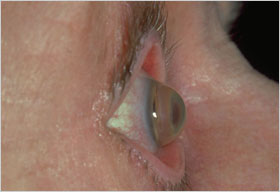Keratoconus
What is Keratoconus?
Keratoconus is an eye disease that causes the cornea of the eye to thin out. This causes the normal spherical shape of the cornea to become irregular, and protrude in a cone-like fashion.
This irregular shape distorts the light passing through the eye, causing the person blurred vision.
Keratoconus is a progressive disease that often develops in your teens and continues to gradually worsen over time. As the disease worsens, it causes irregular astigmatism that in many cases cannot be corrected with lenses alone. The condition usually affects both eyes to some degree.

What Causes Keratoconus?
The exact cause of the corneal tissue thinning has yet to be established.
Keratoconus can affect anyone, but there are a few risk factors that can increase the odds of developing the disease.
These include:
- Heredity – If someone in your family has keratoconus, your chances of developing the disease increase.
- Overexposure to ultraviolet rays
- Poorly fitted contacts
- Chronic eye rubbing
- Certain diseases, including atopic disease and connective tissue disorders
- Down Syndrome
Correction of visual distortion associated with keratoconus can be divided into three tiers. Click each tier to learn about treatment options.
- Mild Keratoconus
- Moderate Keratoconus
- Advanced Keratoconus
For patients with mild keratoconus, glasses and soft contacts can provide immediate vision correction. However, since the disease is progressive, you will reach a point where these lenses don’t do the job anymore.
When the condition worsens to a point where glasses and soft contacts are no longer an option, rigid gas permeable (RGP) contact lenses and other specialty contact lenses are the next stages of therapy.
The rigid lens sits atop the irregular cornea and functions as the new refractive surface of the eye, with lubrication filling in the space between the back of the contact lens and the front of the eye. This is the preferred method of treatment for moderate keratoconus but there are some drawbacks. First, these lenses can be uncomfortable for many people to wear. Additionally, these lenses can be extremely difficult to fit the eye, can be very time-consuming, are expensive, and often require frequent trips to your doctor for adjustments.
Once the disease has reached a point where other options simply won’t work, then surgical options must be pursued. One such option is the insertion of Intacs®, or corneal rings. These are clear plastic rings that are inserted into the edges of the cornea and used to reshape and flatten the cornea to correct vision.
If all other options have been exhausted, then a patient may reach the point where a cornea transplant is necessary. There are two basic types of corneal transplant for keratoconus: full-thickness (penetrating keratoplasty) and partial thickness (deep anterior lamellar keratoplasty – DALK). Price Vision Group specializes in corneal transplants, including the more advanced and difficult DALK procedure that provides a corneal transplant that can last the lifetime of the patient, reduces the risk of both rejection and glaucoma, and can be done in association with a laser to make the wound stronger and heal more quickly.
Data from the Cornea Research Foundation of America database of corneal transplants shows that transplants performed for keratoconus are in the highest category for successful outcomes. The database is currently being used by surgeons at the Price Vision Group to assess methods for reducing post-operative nearsightedness in patients undergoing corneal transplantation.
The Price Vision Group is skilled in the very latest in treatment options for keratoconus and other eye diseases. If you are seeking treatment options for yourself or someone you know, feel free to contact us for an evaluation by calling (317) 844-5530 today
Treatment of Keratoconus
Left untreated, keratoconus can progress to the point where a cornea transplant is needed.
The corneal cross-linking procedure involves the combined use of riboflavin (vitamin B2) eye drops and UVA light to strengthen the front layers of the cornea and is currently the only approved treatment for halting the progression of keratoconus. Dr. Price, one of the most experienced surgeons performing cross-linking in the United States, contributed to FDA approval of cross-linking and served as an investigator in the original US clinical trials, starting back in 2008.
For more information or to schedule an evaluation, please call (317) 844-5530. You can also CLICK HERE for an information sheet on keratoconus and cross-linking.


